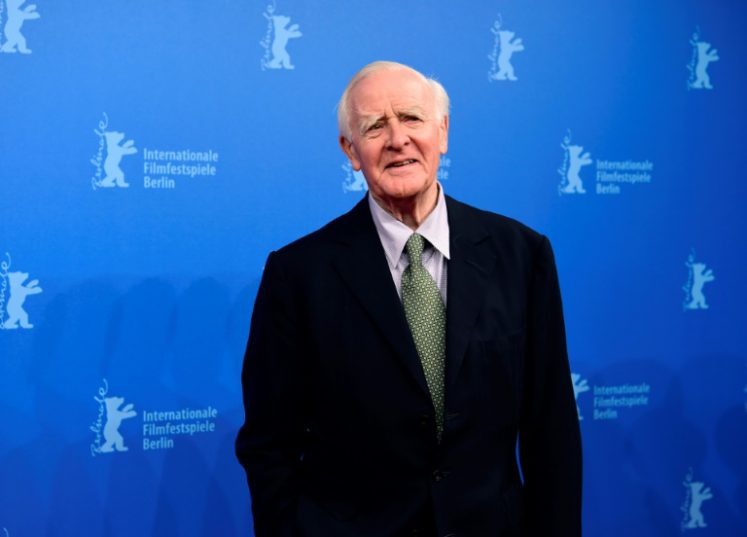But the phenomenon has been put back in the spotlight by Italian publishing sensation Elena Ferrante’s assiduous efforts to keep her real identity a secret, at a time when new reasons are emerging for publishing from behind a mask.
For Ferrante, who was reported last year to have been outed as Rome-based literary translator Anita Raja, anonymity was a choice; born of a desire to avoid the pitfalls of celebrity and a conviction that “books, once written, have no need of their authors”.
Some of her predecessors did not have that luxury.
Alberto Moravia, author of “The Woman of Rome” and one of the greatest figures in 20th Century Italian literature, was born Alberto Pincherle.

John le Carre used his pseudonym when he was still active in Britain’s MI6 intelligence agency
He opted to drop his Jewish family name as part of his efforts to escape censorship and persecution at the hands of Benito Mussolini’s 1922-1943 fascist regime.
Natalia Ginzburg’s first novel, published during the fascist period, appeared under the name of Alessandra Tornimparte and Giorgio Bassani became Giacomo Marchi for similar reasons, journalist Mario Baudino recounts in his recently published, “Lei non sa chi sono io” (“You don’t know who I am”).
That was literally the case for the judges of France’s top literary prize, the Goncourt, when, in 1975, they awarded it to Emile Ajar for “The Life Before Us”, unaware that Ajar was actually a pseudonym for writer Romain Gary.
The latter had already won the prestigious award, in 1956 for “The Roots of Heaven”, and, under the Goncourt’s rules, was excluded from getting it again.
– Real-life spy –
French writer Romain Gary used the name Emile Ajar for his prize-winning book “The Life Before Us”
Gary got round that problem by getting a young cousin to pretend to be Ajar — a subterfuge that was only definitively revealed to the world with the publication of “The Life and Death of Emile Ajar”, an essay written before the writer shot himself in his Paris flat in 1980.
It was not the only time Gary, a World War II pilot, a diplomat and filmmaker as well as writer, managed to hoodwink the literary establishment.
Capable of writing equally well in French and English, he would translate his texts himself under other pseudonyms.
He even occasionally published as Romain Kacew, the name he was born with. “I’ve had a lot of fun. Goodbye and thanks,” was how he signed off his posthumously published farewell note to the world.
“Romain Gary used pseudonyms partly out of his taste for provocation but also because he had the literary concept of the ‘total novel’ in which the author is a character in his own book,” Baudino told AFP.
Gary was a case apart but the journalist found many recurring themes in the stories of writers and their alternative monickers.
Le Carre was adopted when the real-life David Cornwell began writing his spy thrillers while still active in Britain’s MI6 intelligence agency.
Algeria’s Mohammed Moulessehoul, who began writing when he was an army officer, published under his wife’s name Yasmina Khadra to avoid military censorship, only revealing his true identity when he moved to France.
“And there have been many writers who have been exposed like Ferrante,” says Baudino.
– Rejected manuscript –
Stephen King adopted the pseudonym Richard Bachman to sidestep his publisher’s requirement that he release no more than one book per year under his own name
Stephen King, the American master of horror, was a famous example, having eventually been revealed as being the creative force behind the seven novels of a certain Richard Bachman.
Prodigiously productive, King adopted the pseudonym to sidestep his publisher’s requirement that he release no more than one book per year under his own name.
And he also wanted to know whether his success was down to his talent, or the good fortune of having got the breaks that made him an established name: he got a sort of answer when sales of the Bachman books surged following his unmasking.
Nobel literature prize winner Doris Lessing tried something similar when she gave her agent a work under the name Jane Somers: her own publisher rejected the manuscript.
“The choice of a pseudonym is never completely random,” said Baudino, explaining how Henri Beyle became the 19th Century French literary giant Stendhal to distance himself from his hated father.
A few decades earlier, a similar desire to escape the clutches of family led a certain Francois-Marie Arouet to publish under the name Voltaire.
JK Rowling opted for initials on the Harry Potter books for fear her first name, Joanne, would put boys off reading them
A trend reflecting the prevailing sexism of the time saw many accomplished female writers publish their work under masculine names: George Eliot’s real name was Mary Ann Evans, George Sand was Aurore Dupin and the Bronte sisters were first published as Currer, Ellis and Acton Bell.
Lately, partly because of female readers becoming more important to the market for new writing, there has been a trend towards gender neutral pen names.
Thriller writer Tom Knox (real name Sean Thomas) opted for SK Tremayne when he turned to family-based drama, while JK Rowling famously opted for initials on the Harry Potter books for fear her first name, Joanne, would put boys off reading them.
Download our app and read this and other great stories on the move. Available for Android and iOS.